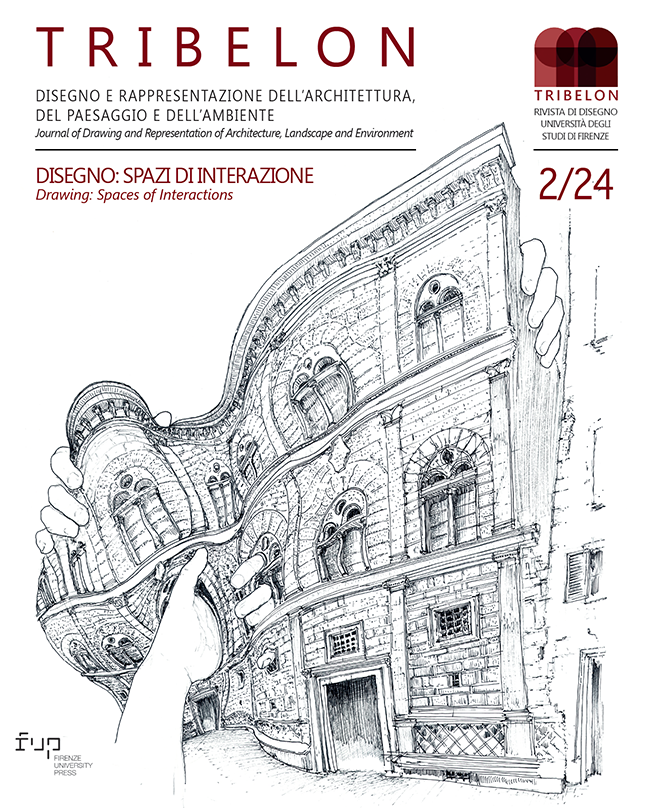Published 2024-12-19
Keywords
- Drawings of Therapeutic Environments,
- Garden and Orchard Drawing,
- Design for Well-being
How to Cite
Copyright (c) 2024 Pilar Chías Navarro

This work is licensed under a Creative Commons Attribution 4.0 International License.
Abstract
The benefits that gardens and orchards provide to the well-being and physical and mental health of those who visit and enjoy them, are known since ancient times. They are places that foster sensory exchanges and encourage the emergence of interpersonal relationships because of taking a temporary hiatus from everyday life. Being at the origin of a prolific classical and medieval, Arabic and Christian literature, they have interesting associated mythologies and iconography. They also appear either as protagonists or as background in numerous artistic representations, from painting to cinema. These traditions materialized in numerous built examples that are still preserved, allowing us to get closer to the prevailing aesthetics of each era, to detect the “traveling species”, and to know how they were conditioned by the qualities of the geographical environment in which they settled. After so many centuries, the drawings of gardens and orchards are not neutral, as they are loaded with connotations and references that belong to the collective imagination and contain the experiences of different cultures. The objective of our research is to reveal this knowledge accumulated through drawing and other ways of representing gardens and orchards, and apply it to design, paying special attention to didactic, inclusive and universal accessibility aspects, and to the most vulnerable users.
References
- M. Belmonte, El murmullo del agua. Fuentes, jardines y divinidades acuáticas, Acantilado, Barcelona 2024.
- A. Berque, Les raisons du paysage: de la Chine antique aux environements de synthèse, Éditions Hazan, Paris 1995.
- R. Calasso, La locura que viene de las ninfas, Sexto Piso, Madrid 2008.
- P. Chías, La Botica del Monasterio de San Lorenzo el Real de El Escorial. Una visión desde la arquitectura, in A. Gomis and R. Rodríguez Nozal (eds.), De la Botica de El Escorial a la Industria farmacéutica: en torno al medicamento. Publicaciones de la Universidad de Alcalá, Alcalá de Henares 2015, pp. 23-66.
- S. Covarrubias Orozco, Tesoro de la lengua castellana, o española, En Madrid, por Luis Sánchez 1611.
- A. Domínguez Ortiz, El Antiguo Régimen: Los Reyes Católicos y los Austrias, Historia de España dirigida por Miguel Artola, vol. III, Alianza, Madrid 1988.
- K. Gareis. Die Landgüterordnung Kaiser Karls der Grossen (Capitulare de villis vel Curtis imperiii). J. Guttentag, Verlag Buchhandlung, Berlin 1895.
- J.W. von Goethe, Die Wahlverwandtschaften, J.G. Cotta’sche Verlagsbuchhandlung, Tübingen 1809 (trad. esp., Las afinidades electiva, Cátedra, Madrid 1999).
- G. A. Herrera, Obra de agricultura, Arnao Guillén de Brocar, Alcalá de Henares 1513.
- F. Íñiguez Almech, Casas Reales y Jardines de Felipe II, CSIC, Delegación de Roma 1952.
- A. Laguna, Pedacio Dioscórides anazarbeo, Acerca de la materia medicinal y de los venenos mortíferos, En Anvers, En casa de Iuan Latio, 1555.
- C. Marcus, M. Barnes, Healing gardens. Therapeutic benefits and design recommendations, John Wiley & Sons, New York 1999.
- Ph. Prevôt, Histoire des jardins, Éditions Sud Ouest, Luçon 2006.
- T. Sánchez-Jáuregui, N. Gutiérrez Pérez, T. Abad, P. Chías, The relationship between healthcare architecture and nature: interaction with the landscape as therapy, in DISEGNARECON, XXXIII, 2024, 17.
- R. Sennet, Carne y piedra. El cuerpo y la ciudad en la civilización occidental, Alianza, Madrid 1997.
- R. Ulrich, Effects of gardens on health outcomes: Theory and research, in Healing gardens: Therapeutic benefits and design recommendations, XXVII, 1999, pp. 27-86.
- G. Vidal, Juliano el Apóstata, EDHASA, Barcelona 1966.


